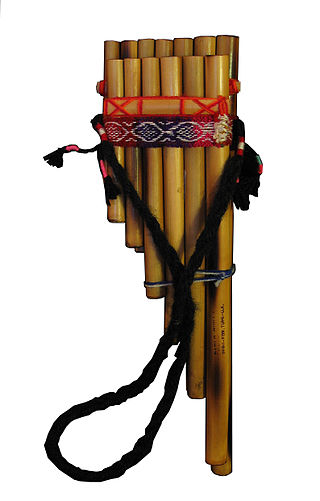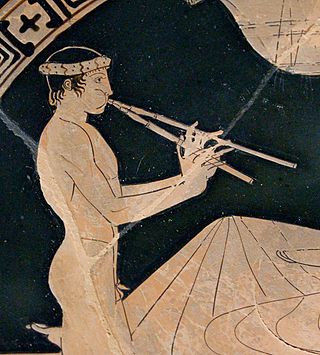
A pan flute is a musical instrument based on the principle of the closed tube, consisting of multiple pipes of gradually increasing length. Multiple varieties of pan flutes have been popular as folk instruments. The pipes are typically made from bamboo, giant cane, or local reeds. Other materials include wood, plastic, metal and ivory.

The Pythian Games were one of the four Panhellenic Games of Ancient Greece. They were held in honour of Apollo at his sanctuary at Delphi every four years, two years after the Olympic Games, and between each Nemean and Isthmian Games. The Pythian Games were founded sometime in the 6th century BC. In legend they were started by Apollo after he killed Python and set up the oracle at Delphi. They continued until the 4th century AD.

In music, the organ is a keyboard instrument of one or more pipe divisions or other means for producing tones. The organs have usually two or three, up to five manuals, for playing with the hands, and pedalboard, with the feet. With the use of registers, several groups of pipes can be connected to one manual.

An aulos or tibia (Latin) was an ancient Greek wind instrument, depicted often in art and also attested by archaeology.

The water organ or hydraulic organ is a type of pipe organ blown by air, where the power source pushing the air is derived by water from a natural source or by a manual pump. Consequently, the water organ lacks a bellows, blower, or compressor.

Dankiyo, is an ancient word from the text of Evliya Çelebi (17th century, Ottoman Era "The Laz's of Trebizond invented a bagpipe called a dankiyo..." describing the Pontian tulum, a type of bagpipe which the ancient Greeks called an askaulos. It consists of a lamb skin, a blow pipe, and the double reed chanter.

A pipe is a tubular wind instrument in general, or various specific wind instruments. The word is an onomatopoeia, and comes from the tone which can resemble that of a bird chirping.

Music was almost universally present in ancient Greek society, from marriages, funerals, and religious ceremonies to theatre, folk music, and the ballad-like reciting of epic poetry. It thus played an integral role in the lives of ancient Greeks. There are some fragments of actual Greek musical notation, many literary references, depictions on ceramics and relevant archaeological remains, such that some things can be known—or reasonably surmised—about what the music sounded like, the general role of music in society, the economics of music, the importance of a professional caste of musicians, etc.

The music of ancient Rome was a part of Roman culture from the earliest of times. Songs (carmen) were an integral part of almost every social occasion. The Secular Ode of Horace, for instance, was commissioned by Augustus and performed by a mixed children's choir at the Secular Games in 17 BC. Music was customary at funerals, and the tibia, a woodwind instrument, was played at sacrifices to ward off ill influences. Under the influence of ancient Greek theory, music was thought to reflect the orderliness of the cosmos, and was associated particularly with mathematics and knowledge.

A salpinx was a trumpet-like instrument of the ancient Greeks.

Diaulos was a double-stadion race, c. 400 metres , introduced in the 14th Olympiad of the ancient Olympic Games.
Greek musical instruments were grouped under the general term "all developments from the original construction of a tortoise shell with two branching horns, having also a cross piece to which the stringser from an original three to ten or even more in the later period, like the Byzantine era". Greek musical instruments can be classified into the following categories:

The karamuza, is a type of Greek reed instrument, likely having descended from the aulos, a common instrument of ancient Greece and Rome. It is made from wood, with a typical length of about 60 cm. The karamuza was extant in Greek music long before the import of the klarino, and its usage is ubiquitous in Greek folk music, particularly in Thessalia, the Peloponnese, and Macedonia.

The double flute is an ancient category of wind instrument, a set of flutes that falls under more than one modern category in the Hornbostel Sachs system of musical instrument classification. The flutes may be double because they have parallel pipes that are connected with a single duct. They may be "double vertical flutes" without a duct. There is also a double-transverse flutes.

In ancient Greece and Rome, the tympanon (τύμπανον) or tympanum, was a type of frame drum or tambourine. It was circular, shallow, and beaten with the palm of the hand or a stick. Some representations show decorations or zill-like objects around the rim. The instrument was played by worshippers in the rites of Dionysus, Cybele, and Sabazius.
Kathleen Schlesinger was a British music archaeologist and curator of musical instruments at the British Museum. She specialized in the history of musical instruments and was called in 1911 "the greatest authority on the subject". In 1939, her Greek Aulos presented her analysis of the modes used on aulos instruments in ancient Greek music.

Music technology is the study or the use of any device, mechanism, machine or tool by a musician or composer to make or perform music; to compose, notate, playback or record songs or pieces; or to analyze or edit music.

Mechanical music technology is the use of any device, mechanism, machine or tool by a musician or composer to make or perform music; to compose, notate, play back or record songs or pieces; or to analyze or edit music. The earliest known applications of technology to music was prehistoric peoples' use of a tool to hand-drill holes in bones to make simple flutes. Ancient Egyptians developed stringed instruments, such as harps, lyres and lutes, which required making thin strings and some type of peg system for adjusting the pitch of the strings. Ancient Egyptians also used wind instruments such as double clarinets and percussion instruments such as cymbals. In Ancient Greece, instruments included the double-reed aulos and the lyre. Numerous instruments are referred to in the Bible, including the horn, pipe, lyre, harp, and bagpipe. During Biblical times, the cornet, flute, horn, organ, pipe, and trumpet were also used. During the Middle Ages, hand-written music notation was developed to write down the notes of religious Plainchant melodies; this notation enabled the Catholic church to disseminate the same chant melodies across its entire empire.

The Reading Aulos is the surviving half of an ancient Greek aulos. It is much more complete than other examples found to date, and is on permanent display at the Ure Museum of Greek Archaeology in Reading, England.

















